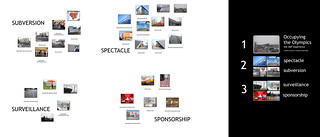Occupying the Olympics
Last month, I had a photo essay published in the Dutch architecture journal S+RO. Their special Olympic Cities edition covers a range of subjects, mine presents an overview of ways of seeing the Olympic city, framed by the following proposition:
Occupying the Olympics: Spectacle, Subversion, Surveillance, Sponsorship
Sponsorship, surveillance, spectacle and subversion are not discrete categories within the Olympic city. Everyone attempts to hijack each others' message or get around the other's guidelines.
The International Olympic Committee limits the sponsors' privilege by forbidding their presence within Olympic venues. The sponsors limits the host city's privilege by securing all billboard space for their own campaigns and erecting their own meta-event within the mega-event with vast temporary buildings and by staging their own Olympic programme. The Host City draws people away from the sports towards experiencing their culture and heritage, in order to recover some of their financial loss. Spectators roam the streets searching for scalpers' tickets, finding that the only scalpers are executives from top sponsors who have wads of free tickets they will sell at face value. Even the athletes try to get around the rules by doping.
The Olympic park is a new kind of theme park – 'a theme park without a theme' as writer Iain Sinclair put it in his latest book Ghost Milk. However, the park is no longer enclosed; the city has become the park. For London 2012, there is already a big wheel installed for tourists to ride.
This world is not hyper-real like a Disneyland, but an Uberland where consumption even relies on its own global currency – VISA, the exclusive card of all Olympic activity. All 204 visiting nations are able to access the Olympic experience by this simple chip and pin transaction, while London 2012 banks on providing its second Austerity Olympics anxious that the city may be burning with unrest, as it was in the summer of 2011.
These images tell stories of alternative Olympic experiences the protests that go unnoticed by the 20,000 journalists who shuffle form one sports venue to the next blinkered from what happens in the city.


